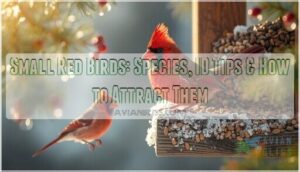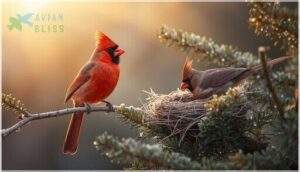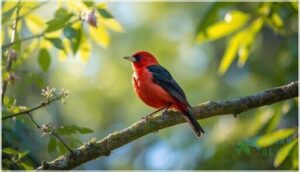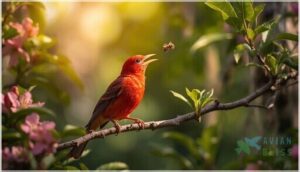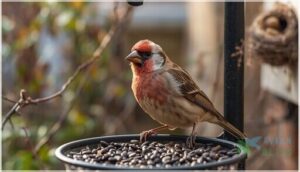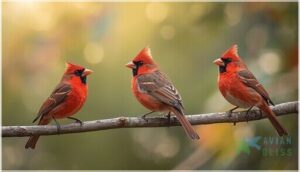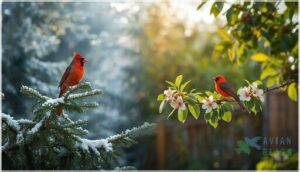This site is supported by our readers. We may earn a commission, at no cost to you, if you purchase through links.
A flash of crimson at your feeder stops you mid-sip of morning coffee. You’re not alone—small red birds captivate backyard birders across North America, from the Northern Cardinal’s year-round presence to the Scarlet Tanager’s brief summer visits.
These vibrant species aren’t just eye candy. Their red plumage comes from carotenoids in their diet, transforming berries and seeds into feather pigments that signal health and vitality.
Identifying them takes more than spotting red feathers, though. Beak shape, body size, and subtle color patterns separate a House Finch from a Purple Finch or a Summer Tanager from its scarlet cousin. Once you know what to look for, you’ll turn casual sightings into confident identifications—and discover simple ways to bring these colorful visitors straight to your yard.
Table Of Contents
- Key Takeaways
- What Are Small Red Birds?
- Common Species of Small Red Birds
- How to Identify Small Red Birds
- Habitats and Distribution of Small Red Birds
- Attracting and Supporting Small Red Birds
- Frequently Asked Questions (FAQs)
- What is a little red bird not a cardinal?
- What bird is small and red?
- What is the little red bird that looks like a sparrow?
- Is there a red finch bird?
- Whats the difference between male and female red birds?
- Where can I find red birds in the fall?
- How can I identify small red birds?
- Are there any small red birds that arent cardinals?
- What are some good resources for bird identification?
- What sounds do small red birds make?
- Conclusion
Key Takeaways
- Small red birds like cardinals, tanagers, and finches get their vivid red plumage from carotenoids in their diet—berries and seeds literally transform into feather pigments that signal health and vitality.
- You can separate species by checking three key features: beak shape (thick orange bills mean cardinals, pale slender ones suggest tanagers), body markings (like Scarlet Tanagers’ black wings versus Summer Tanagers’ solid rose-red), and size differences ranging from 4 to 9 inches.
- Male red birds flash bright crimson feathers to attract mates while females wear muted browns and tans—this color difference between sexes helps you identify what you’re seeing at your feeder.
- Attracting these birds to your yard requires black-oil sunflower seeds in platform feeders, native berry shrubs for natural food sources, and shallow birdbaths placed near dense cover for safety.
What Are Small Red Birds?
You’ve probably spotted a flash of red in your backyard and wondered what bird just flew by. Small red birds come in several species, and they’re not all cardinals.
Let’s break down what makes these birds “small red birds” and how you can tell them apart from their larger cousins.
Defining Small Red Birds
You might spot a flash of red and wonder what you’re seeing. Small red birds aren’t just one species—they’re a diverse group of finches, tanagers, and flycatchers, usually under eight inches long. Cardinals, Scarlet Tanagers, and Red Crossbills all wear crimson feathers, but they belong to different families.
Red plumage genetics trace back to dietary carotenoids, which these birds convert into vivid reds through specialized metabolism. Understanding small red birds can help in identifying the various species that exist.
Typical Size and Physical Traits
Once you know what you’re looking at, you’ll notice these small red birds range from 4 to 9 inches long. House Finches weigh barely an ounce with short wings and long tails, while Cardinals push nearly 2 ounces with sturdy bodies.
Beak variations tell stories—Cardinals sport thick orange-red bills for cracking seeds, whereas Scarlet Tanagers carry pale, stout beaks. Male bird plumage shows the most dramatic reds, helping you spot feather patterns and body proportions that distinguish one species from another.
These birds often visit urban bird feeders to eat seeds and fruits.
Differences From Cardinals and Similar Species
Cardinals stand out with their signature crest and black facial mask—features you won’t find on Scarlet Tanagers or Summer Tanagers. Beak comparison reveals cardinals’ thick orange bills versus tanagers’ slender pale ones.
Plumage variations matter too: Scarlet Tanagers flash black wings, while Hepatic Tanagers show duller reds.
Song patterns and nesting habits differ across small red birds, helping you distinguish each species in your backyard.
Common Species of Small Red Birds
You’ll come across several small red birds across North America, each with its own look and personality. Some stick around all year, while others only show up for part of the season.
Let’s break down the most common species you’re likely to spot in your backyard or on a trail.
Northern Cardinal
You’ve probably heard Northern Cardinals singing from your backyard—these iconic small red birds don’t migrate, staying put year-round across eastern North America. Males flash striking red plumage with black face masks, while females wear softer brown tones with reddish highlights. Both sport that signature crest and thick orange bill.
Watch their nesting habits in dense shrubs, where pairs raise two to three broods annually while maintaining devoted feather care routines.
Scarlet Tanager
The Scarlet Tanager’s vivid red plumage with jet-black wings makes it one of the most stunning small red birds you’ll spot in mature deciduous forests. These long-distance migrants travel between eastern North America and South America annually, favoring large forest tracts for breeding.
- Males display scarlet bodies during breeding season while females wear yellowish-green year-round
- Diet composition shifts from 80% insects in summer to berries and fruit in fall
- Song recognition challenges exist since their call resembles other forest songbirds
- Breeding habits include laying 3-5 pale blue eggs in high canopy nests 10-30 feet up
Summer Tanager
With rose-red plumage year-round, the Summer Tanager stands out among small red birds as a bee-hunting specialist. You’ll spot this 6.7-inch tanager in southern forests and riparian woodlands before it migrates to Central America each fall.
| Feature | Male | Female |
|---|---|---|
| Body Color | Rose-red | Yellow-olive |
| Wing Pattern | Solid red | Yellowish |
| Size | ~6.7 inches | ~6.7 inches |
| Weight | ~1 ounce | ~1 ounce |
| Beak | Pale horn | Pale horn |
Summer Tanagers specialize in catching bees and wasps mid-flight, then remove stingers before eating. Their diet shifts to berries during tanager migration, building fat reserves for 860 km flights. With 12 million individuals globally, bird conservation efforts keep this species stable, though habitat loss threatens local populations along rivers like the Colorado.
Summer Tanagers hunt bees mid-flight, remove stingers before eating, then shift to berries for long migrations despite habitat loss threats
House Finch
You’ll find House Finches thriving in backyards across North America—a true urban adaptation success story. Males sport rosy-pink throats and streaked bellies, while females wear brown tones.
At 5-6 inches, these small red birds prefer black oil sunflower seeds at feeders.
Their shallow cup nests appear in trees or building ledges, with breeding pairs raising up to three broods yearly.
Other Notable Red Birds (e.g., Vermilion Flycatcher, Purple Finch)
Beyond these familiar faces, you’ll encounter other striking small red bird species worth knowing. The Vermilion Flycatcher dazzles with its 5-inch vermilion body and dark mask, inhabiting southwestern deserts and riparian zones. Purple Finches, sadly declining 32% since 1966, show raspberry-red males in northern forests.
Understanding red bird migration patterns and supporting finch conservation through cat control and window strikes helps these species thrive during your birdwatching adventures.
How to Identify Small Red Birds
When you spot a flash of red in your backyard, you’ll want to know exactly what you’re looking at. Identifying small red birds comes down to a few key features that separate one species from another.
Let’s break down the main traits you should watch for when a crimson visitor stops by.
Plumage Colors and Patterns
You’ll notice red pigmentation varies wildly across species—some birds flash uniform scarlet feathers while others show patchy color variation. Here’s what to watch for:
- Contrast patterns: Scarlet Tanagers sport bright red bodies with jet-black wings
- Red hue intensity: Males usually display richer tones than females
- Plumage markings: Streaks, masks, or mottling help distinguish species
Feather structure and red plumage variation reveal each bird’s identity story.
Beak Shape and Color
Beak morphology unlocks each red bird’s secret identity. You’ll spot thick, conical beaks on House Finches cracking seeds, while Scarlet Tanagers wield slender beaks for snatching insects. Red pigmentation—driven by carotenoid effects from their diet—brightens during the breeding season, signaling health and vitality.
| Species | Beak Shape | Color Patterns |
|---|---|---|
| Northern Cardinal | Thick, triangular | Bright orange-red |
| House Finch | Short, conical | Dull red-orange |
| Scarlet Tanager | Slender, pointed | Pale yellow-gray |
These red bird characteristics guide your bird identification adventures in the wild.
Body Size and Shape
Once you know beak shapes, body proportions reveal the rest. Size separates a chunky Cardinal (8.3–9.3 inches, 1.58 oz) from a dainty Vermillion Flycatcher. You’ll notice:
- Wing Span: Cardinals stretch to 31 cm; Red Crossbills hover around 27 cm.
- Tail Sizes: Scarlet Tanagers sport squared tails; Hepatic Tanagers show broader fans.
- Feather Length: Compact nuthatches versus elongated tanagers.
These clues crack any ID puzzle.
Male Vs. Female Color Differences
Color genetics reveal mating strategies fast. Male Cardinals flash scarlet plumage while females wear muted browns—that dimorphism evolution helps you nail sex determination. Male House Finches sport bright red chests; females stay streaked and dull. Scarlet Tanagers? Males go vivid red with black wings; females choose olive-yellow.
This plumage variation isn’t random—it’s survival meeting reproduction, and it’s your quickest route to identifying red birds in the field.
Habitats and Distribution of Small Red Birds
Where you spot small red birds depends on the species and the time of year. Some thrive in deep forests and woodlands, while others hang out in your backyard or city parks.
Let’s look at where these birds live across North America and how they move with the seasons.
Forests, Woodlands, and Urban Areas
You’ll find small red birds thriving across diverse landscapes—from dense forests where Scarlet Tanagers and Hepatic Tanagers prefer mature canopy cover, to urban backyards welcoming Northern Cardinals and House Finches.
Woodland conservation and thoughtful urban planning create essential corridors that counter habitat fragmentation. Even Red Crossbills adapt to coniferous stands.
Your backyard birds benefit when biodiversity management balances forest ecology with city green spaces.
Regional Ranges in North America
Geographic distribution tells a fascinating story. Northern Cardinals dominate the eastern US and southeastern Canada, while Summer Tanagers favor southern woodlands from Texas to the Atlantic. Scarlet Tanagers breed across eastern deciduous forests. House Finches spread coast to coast after eastern introductions.
Range overlaps occur in riparian corridors and mixed forests, where conservation efforts protect these breeding habitats across North America.
Migration Patterns and Seasonal Movements
Migration patterns split small red birds into distinct groups. Scarlet Tanagers travel nocturnally from northeastern forests to South America, using stopover sites to refuel. House Finches migrate short distances during daylight, seeking lower elevations with feeders. Northern Cardinals stay put year-round.
Understanding these seasonal trends and habitat selection helps with bird watching and aids wildlife conservation efforts protecting migration routes.
Attracting and Supporting Small Red Birds
Bringing small red birds to your yard takes more than luck—it takes the right setup. Focus on food, shelter, and a few simple habits that make these birds feel at home.
Here’s what works best to attract and support them in your space.
Birdseed and Feeder Preferences
You’ll have the best luck attracting small red birds like House Finches and cardinals by offering black-oil sunflower seeds in platform or large hopper feeders. Specialized seed blends with sunflower and millet work well for backyard birding.
These seed types deliver essential fats and proteins for bird nutrition, especially during winter.
Cardinals prefer feeding at dawn and dusk, so keep feeders stocked during these peak times for maximum bird feeding and attraction.
Creating a Bird-Friendly Habitat
You can transform your backyard into a sanctuary by planting native berry shrubs like American Holly and serviceberry—these draw small red birds year-round.
Add a shallow birdbath 1-3 inches deep near dense cover for safety. Skip pesticides to boost insect conservation, and layer brush piles for bird shelter.
This habitat design enhances backyard birding tips while promoting wildlife habitat preservation naturally.
Conservation and Responsible Birdwatching
You can protect small red birds by supporting habitat restoration and bird-friendly practices like shade-grown coffee. Conservation efforts rely on your observations—platforms like eBird use citizen science to track populations and inform environmental policy.
When birdwatching, don’t disturb nests or habitats. Responsible wildlife conservation strengthens ecological balance. Your participation in sustainable tourism and habitat conservation directly advances conservation biology while safeguarding threatened species like the Red Siskin.
Frequently Asked Questions (FAQs)
What is a little red bird not a cardinal?
Think of a flash of red in the trees like a spark that doesn’t belong to cardinals. You might spot a House Finch with rosy streaks or a Scarlet Tanager showing black wings.
What bird is small and red?
Several small red bird species exist, including the House Finch with red plumage on males, the Vermilion Flycatcher at 5 inches, and the Red Crossbill with its distinctive crossed bill.
What is the little red bird that looks like a sparrow?
The House Finch is your most likely suspect—males sport red faces, breasts, and rumps with thick grayish beaks. Unlike sparrows, they show vibrant red plumage, especially in urban and suburban settings across North America.
Is there a red finch bird?
Yes, the House Finch is often called a red finch. Males display bright red plumage on their heads and breasts.
Red Finch Species also include Purple Finch and Cassin’s Finch across North America.
Whats the difference between male and female red birds?
Male red birds display bright red plumage and darker beaks, while females show brown or tan feathers with soft red accents.
This sexual dichromatism helps males attract mates during breeding season.
Where can I find red birds in the fall?
Cardinals stick around your feeder all fall, but scarlet tanagers? They’re long gone to South America by October.
Check woodland edges in the eastern U.S. for the best autumn sightings.
How can I identify small red birds?
Start with plumage patterns—males show bright red feathers, females display muted tones.
Check beak shapes and bird sizes next.
Wing markings and feather colors complete your backyard bird identification guide for red birds species descriptions.
Are there any small red birds that arent cardinals?
Absolutely—you’ll spot scarlet tanagers in forest canopies, summer tanagers catching bees mid-flight, vermilion flycatchers in arid scrublands, and house finches at backyard feeders, each flashing red plumage adaptations that rival any cardinal’s brilliance.
What are some good resources for bird identification?
You can use bird identification apps like Merlin App and Sibley Apps, plus online databases such as eBird Tools and All About Birds.
These wildlife identification resources help with avian species recognition anywhere you go.
What sounds do small red birds make?
You’ll hear distinct vocal patterns across red bird species. Northern Cardinals deliver clear whistles like “cheer, cheer” with metallic chips. House Finches warble sweetly with buzzy endings, while tanagers produce robin-like melodic phrases.
Conclusion
For creatures barely larger than your palm, small red birds command outsized attention. Their color—earned bite by bite from seeds and berries—turns them into biological billboards you can’t ignore.
Now you’ve got the field marks, habitat clues, and feeder strategies to separate cardinals from tanagers and finches. Stock sunflower seeds, plant native shrubs, and watch your yard become their stage.
That morning flash of crimson? You’ll know exactly who’s visiting.

